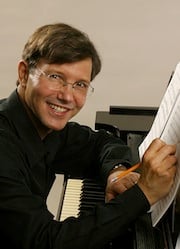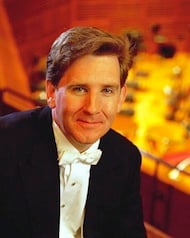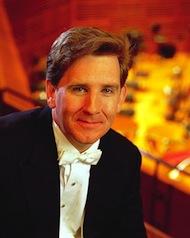
My route from San Francisco to San Rafael for Sunday’s Marin Symphony concert at the Marin Center took me along Presidio Parkway for the first time. From this sleek replacement for the decrepit Doyle Drive, I kept getting new sightlines and gleaming fresh perspectives of the Golden Gate Bridge up ahead. It doesn’t matter how many times you’ve seen or crossed it. This great engineering marvel, quite possibly the world’s most lyrical span, keeps renewing its power to delight.
The drive had me primed for Chrysoplylae, the Marin Symphony‘s ambitious Golden Gate commission to celebrate the bridge’s 75th anniversary. In a sonically immersive collaboration by composer Rob Kapilow and sound designer Fred Newman, bird calls and foghorns merged with mighty tone clusters and a jaunty swing tune. The staticky recorded voice of San Francisco Chief Engineer Joseph Strauss joined the parade, along with melodies and lyrics that invoked the Ohlone and Miwok Indian tribes. There was a mini choral requiem for the bridge’s many suicides. According to Kapilow’s program note, a 12-tone row paid tribute to the dozen workers who plunged from broken scaffolding and fell through a safety net on Feb. 17, 1937.
There wasn’t much about the bridge that this four-movement, 30-minute work didn’t try to capture. The result was something at once admirable, like a grand vista of the structure itself, and a little generic and remote, the musical equivalent of a documentary that seemed a bit overwhelmed by its subject. By trying to be so many things, Chrysopylae (Greek for golden gateway or passageway) played more as a pastiche than a compelling whole. Ideas weren’t so much developed and integrated as they were referenced and cataloged.
Following a blessing by two Miwok tribal leaders, the piece began with the hall in darkness. Wind, water, and bird sounds rose in a kind of aural creation myth, delivered by Newman’s sensual sound score. The orchestra, under Music Director Alasdair Neale’s baton, chipped in with some moaning undertow, chittering bird sounds and an extended passage of tribally inflected percussion.
The result was something at once admirable, like a grand vista of the structure itself, and a little generic and remote, the musical equivalent of a documentary that seemed a bit overwhelmed by its subject.
Newman’s sound score dominated in the early going, notably in the clangorous passage devoted to the building of the barrage. But as a xylophone appropriated the jackhammer’s insistent beat, the musical tide began to rise. With the arrival of the swing tune, the piece took on a sense of time and place, of excitement and aspiration, that didn’t depend so much on the period voices and sounds to make its impact. The sound score, at points, became intrusive and redundant. The hybrid quality of the piece — ceremonial composition, sound environment, quasi film score — was intriguing and productive in spots but also discordant.
Kapilow, who is best known for his engaging “What Makes It Great” series of musical talks, supplied some forceful imagery. A grandly ascendant chord progression suggested the majesty of the towers and suspension cables. Clotted dissonance conveyed the despair of the suicidal bridge jumpers. A nostalgic sweetness, augmented by the tinkle of bicycle bells, captured the sense of perpetual movement, then and now, across the past 75 years. The flutes sighed and floated in bird-like farewell near the end, when once again the sound delivered us back to the primal murmur of water and wind and seagulls drifting out of earshot.

The libretto, sung by the Marin Symphony Chorus, was an odd jumble of the lyrical, the literal (“83,000 tons of structural steel”) and the incantatory (“75 years! 75 years!”). Earnest, overstuffed, fitfully attractive, and sometimes touchingly poetic, Chrysopylae simultaneously over-reached and underachieved. Whatever its shortcomings, the piece’s grand ambition lingered. The bridge’s towers looked especially tall and proud on the drive back across the Golden Gate.
After intermission, Neale led a taut, lucid and vigorous reading of Beethoven’s Ninth Symphony. The opening Allegro set the precisely drawn and dynamic path, with a sense of pent-up energy especially evident in the excellent strings. Neale’s ear for the piece’s dramatic dislocations prevailed throughout, the timpani protesting violently, the French horns braying, the woodwinds sounding brawny even when they burbled. It was a youthful, exciting account throughout, even when a detail got lost in the shuffle or the balance went awry.
Baritone Eugene Brancoveanu led the way among the soloists. Tenor Brian Thorsett was a little light-voiced, but came off as an agile drum major in the brass-band oom-pah section of the final movement. Soprano Ronit Widmann-Levy and mezzo Julie Anne Miller more than held their own in this rousing conclusion to full and eventful afternoon in Marin.

